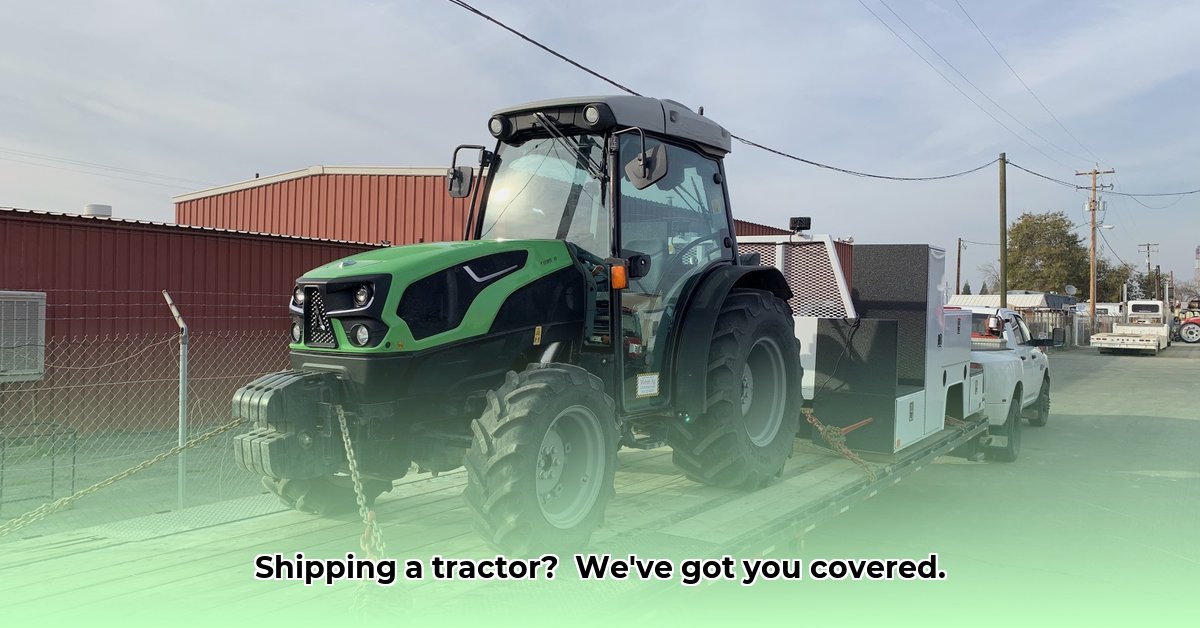
Shipping a tractor requires careful planning and execution. This guide provides a step-by-step process, from initial planning to delivery, ensuring a smooth and safe transport of your valuable equipment. Whether you're a farmer, dealer, or equipment owner, this guide will help you navigate the complexities of tractor shipping. For tire pressure specifics, consult this helpful resource on tire pressure.
Planning Your Tractor Shipment: Laying the Groundwork
Before your tractor embarks on its journey, thorough planning is essential. This section outlines the key preparatory steps.
Determine Tractor Dimensions and Weight: Accurately measure your tractor's length, width, height, and weight. This information is crucial for selecting the appropriate transport method and obtaining necessary permits. Inaccurate measurements can lead to delays and increased costs. Why is accurate measurement so crucial? It ensures the right type of trailer is used and prevents potential issues with weight limits and permits.
Identify Origin and Destination: Clearly define the pickup and delivery locations, including specific addresses and contact information. Ambiguity in these details can cause confusion and delays. What's the impact of unclear addresses? Ambiguous locations lead to additional time and potential charges for the carrier locating your equipment.
Research Shipping Methods: Three primary methods exist: open trailers (cheaper, but expose your tractor to the elements), enclosed trailers (more expensive, greater weather and theft protection), and specialized trailers for oversized or heavy tractors. The choice depends on your budget and the value/sensitivity of your equipment. How do I choose the best method? Consider your budget, the weather conditions in transit, and the overall value of your tractor.
Choosing Your Shipping Provider: Finding the Right Partner
Selecting a reliable shipping provider is vital. This section compares two common approaches: online marketplaces and dedicated tractor transport companies.
Online Marketplaces (e.g., uShip): These platforms allow multiple carriers to bid on your shipment, potentially leading to competitive pricing. However, service quality can vary significantly. What are the trade-offs with online marketplaces? You may obtain lower prices, but the selection process can lead to less control over the final carrier assigned to your equipment.
Dedicated Tractor Transport Companies: These companies specialize in transporting tractors, offering more consistent service and direct communication. Expect higher upfront costs due to their specialization and potentially higher insurance coverage. What are the benefits of a specialized carrier? They have experience in handling tractors, leading to potentially safer and more reliable transport.
Comparison Checklist: Use this checklist to evaluate potential providers:
| Feature | Online Marketplace (e.g., uShip) | Dedicated Tractor Transport Company |
|---|---|---|
| Price | Variable, competitive bidding | Fixed or negotiated rate |
| Carrier Selection | Limited choice | Direct selection |
| Insurance | Varies, requires careful review | Typically included, verify details |
| Communication | Primarily online | Direct contact, faster communication |
| Reliability | Carrier-dependent | Generally higher |
Obtaining Necessary Permits and Documentation: Legal Compliance
Before transport, ensure you comply with all relevant regulations. This section details the essential legal aspects.
Permits: Contact local and state transportation authorities to check permit requirements for oversized or overweight loads. Regulations vary across jurisdictions. What happens if I fail to obtain the necessary permits? You may face fines or even have your shipment stopped mid-route.
Insurance: Secure adequate insurance coverage to protect against damage or loss during transit. Verifying the insurance policy's details is critical. What's the crucial coverage to confirm? Ensure sufficient coverage for the full value of your tractor in case of theft or damage.
Documentation: Gather all necessary paperwork, including the shipping contract, insurance policy, and any permits obtained. Organize your documents for easy access. Why is meticulous documentation vital? Having organized paperwork reduces stress and helps resolve issues if shipment difficulties occur.
Preparing Your Tractor for Shipment: A Pre-Departure Checklist
Preparing your tractor is critical for a safe journey. Follow this step-by-step checklist:
Cleaning: Thoroughly clean your tractor, removing mud, debris, and any loose attachments. Why is cleaning critical? Improves handling, prevents damage, and ensures accurate inspection records in the case of any damage during transit.
Fluid Drainage: Partially drain fuel tanks (reducing fire risks and weight), engine oil, and any other fluids according to the manufacturer's recommendations. What is the risk if you don't partially drain fluids? Overfilled tanks can shift, causing damage or even fires in transit.
Secure Attachments: Remove or securely fasten all implements or attachments to prevent damage during transport. How should attachments be secured? Use strong, appropriate tie-downs, and take photos for documentation purposes.
Documentation: Take detailed photos and videos of your tractor's condition before shipment. This serves as evidence of its initial state. Why should you document the initial condition? In case of disputes or damage claims, pictures and videos provide irrefutable evidence of the tractor's condition before shipment.
Monitoring the Shipment, Receiving and Unloading: The Journey's End
This section details the steps from dispatch to delivery.
Shipment Tracking: Utilize the provider's tracking system to monitor your tractor's progress. Most shippers offer real-time updates. Why is consistent tracking essential? It allows for early detection of potential problems, such as delays or accidents, and ensures proactive communication with the carrier.
Arrival and Inspection: Be present at the destination for unloading. Conduct a thorough inspection upon arrival, documenting any damage with pictures and contacting the provider immediately if issues are found. What should the post-delivery inspection entail? Note any and all damage--large or small--take pictures, and report issues right away to the provider to initiate a potential claim.
Conclusion: A Successful Tractor Transport
Shipping a tractor successfully involves careful planning, informed decision-making, and attention to detail. This guide outlines a structured approach to minimize potential issues. Remember, the preparation you invest in ensures a smoother and safer delivery of your valuable equipment. By following these steps and working with a reputable shipper, you can confidently transport your tractor to its destination.